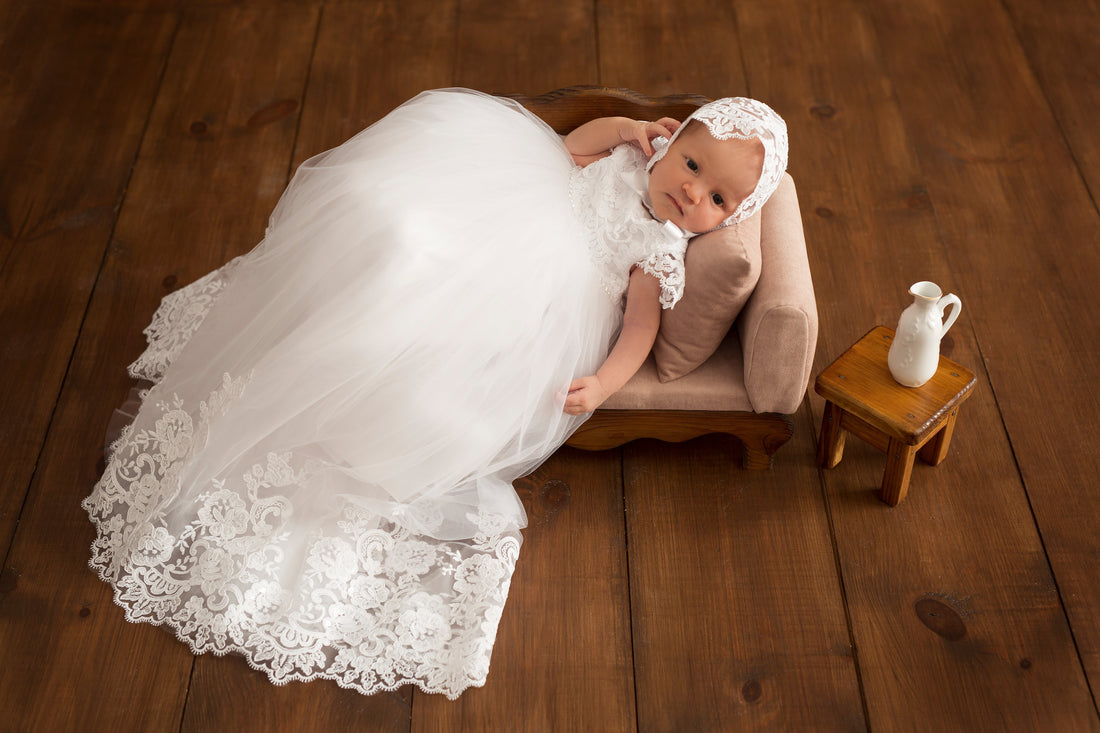
🌍 Baptism Traditions Around the World: What Makes Yours Special?
Share
Baptism is a beautiful and deeply meaningful rite of passage for families of faith. While the core purpose — welcoming a child into the spiritual community — remains universal, the ways in which baptisms are celebrated around the world vary widely. From the clothing to the customs, from the gifts to the godparent roles, every tradition carries its own beauty.
Whether you come from a rich cultural heritage or are exploring baptism for the first time, understanding these differences — and what they mean — can help you create a ceremony that feels truly personal.
👗 What Babies Wear: A World of Styles
While most Americans associate baptism with a long white gown, other cultures bring their own touches to this special day:
- United States & Western Europe:
Long white or ivory gowns are the traditional choice for both boys and girls. These gowns often feature lace, embroidery, and heirloom elements. Accessories like bonnets, bibs, and booties complete the look. In modern American families, personalized embroidery is becoming more popular — from initials to baptism dates on booties or bibs.
- Eastern Orthodox countries (Greece, Ukraine):
Babies are often wrapped in white linen or cotton towels and dressed in simpler garments after the immersion. Handmade outfits and custom embroidery are common, and godparents play a major role in preparing the baby’s attire.
- Latin America:
Baptismal clothing is often elaborate, with detailed lacework and layered fabrics. Family traditions are strong, and gowns are frequently passed down through generations. In some regions, gold jewelry is a popular baptism gift.
- Philippines & Southeast Asia:
Families may blend Catholic traditions with local customs. Babies are dressed in white, but ceremonies can be more festive, including music, extended family gatherings, and symbolic offerings.
💡 No matter the tradition, the focus is always the same: purity, new beginnings, and the love surrounding your child.



⚪ Why White? The Symbolism Behind the Color
White is more than just a color choice — it’s a symbol.
- Purity: It represents innocence and a fresh start for the soul.
- Light: In many Christian denominations, white clothing symbolizes the light of Christ entering the child’s life.
- Joy: White has long been associated with celebration, blessing, and hope for the future.
In some families, the gown is intentionally passed from child to child, becoming a family heirloom. Others choose a brand-new dress, personalized with the baby’s name or a meaningful phrase — blending tradition with modern meaning.
💒 Baptism Expectations in the U.S.
Baptism traditions in the United States vary by denomination and family preference, but here are a few key patterns:
✝️ Catholic Families:
- Infants are usually baptized within the first year.
- A long gown is expected, even for baby boys.
- Godparents often provide part of the baptism outfit or personalized gifts.
- Ceremonies may include anointing with oils and a white candle.
✝️ Protestant Families:
- Traditions vary widely — some opt for formal ceremonies, others for more casual gatherings.
- Outfits may be simpler or less traditional.
- Dedication ceremonies (rather than baptism) are common in some denominations.
✝️ Orthodox Families:
- Full immersion is traditional, even for infants.
- Babies are usually undressed, then clothed in a white garment post-ceremony.
- Godparents have a very active role, including providing the full baptismal set (clothes, towels, candle, etc.).
🇺🇦 Ukrainian Traditions: A Blend of Faith, Craft, and Family Legacy
In Ukrainian culture, baptism — or khrystýnny — is a sacred and emotional event, often deeply rooted in both Orthodox Christian beliefs and family heritage. Babies are traditionally dressed in handmade white garments, often sewn by the mother or gifted by the godparents. These outfits are typically made of natural linen or cotton and decorated with delicate embroidery, sometimes in traditional patterns passed down through generations.
A key element in Ukrainian baptism is the towel (rushnyk), a symbolic cloth used to wrap the baby after baptism, representing protection and blessing. It’s common for families to preserve both the towel and the gown as heirlooms, tucked away for future siblings — or even future generations.
Today, many Ukrainian-American families honor these customs by incorporating custom embroidery, linen gowns, and full accessory sets — from bonnets to bibs — into their child’s baptism, blending ancestral meaning with modern elegance.

🌟 Making It Personal
You don’t have to follow one tradition exactly. Many American families now choose to blend cultural heritage, faith traditions, and modern touches:
-- A classic linen gown paired with a personalized embroidered bib
-- A traditional white dress with handmade accessories from grandma
-- An heirloom passed down from generations, paired with a new custom bonnet
The beauty of modern baptism is that there’s room for both tradition and individuality. What makes your baptism special is the love and care you put into it — whether that means continuing your family’s customs or starting your own.
💖 Final Thought
No matter where you're from or what your background is, baptism is a celebration of love, faith, and new life. Take inspiration from the many beautiful traditions around the world — and then make it your own.
Because in the end, what makes your baptism special is the story it begins for your child.
